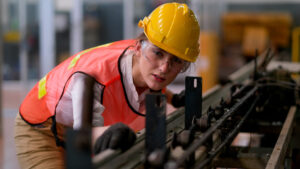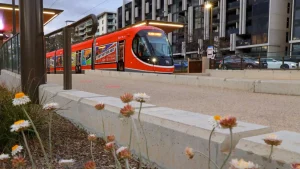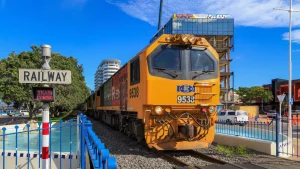Creating your competitive advantage
When KiwiRail’s Technology and Innovation Lead, Soren Low, saw the results of their first Driving Advice System (DAS) trial, he thought the fuel efficiency numbers must be too good to be true.
Fast forward a few years from this initial application and the technology had been rolled out across the business, with the TTG team installing onboard systems in 180 locomotives and training 350 drivers to use the system.
By implementing DAS, KiwiRail reduced fuel costs by more than 13 per cent[i] while meeting ambitious emissions reduction targets and improving its service to customers, enabling more goods to be moved by rail instead of by road.
Soren and the KiwiRail team created this competitive advantage for themselves by identifying that TTG’s DAS solution is a single software platform that positively impacts multiple areas of a rail operating business.
KiwiRail is just one example of many rail companies worldwide – like yours – that are considering the opportunities for greater efficiencies presented by technology. Your roadmap to selecting and implementing a new solution will include addressing the concerns and priorities of colleagues across your organisation, from drivers to the C-suite.
Developing your understanding of the proven TTG DAS technology helps you support these stakeholders by addressing areas of your business that will benefit – from planning and scheduling to operations, procurement, and management.
Real-time advice for drivers
Operational efficiency levels can vary by as much as 50 per cent between your highest and lowest-performing drivers using identical train configurations on the same route.
This alarming range creates uncertainty within your business and can’t be explained away by newer drivers taking time to learn their route or equipment. Even the most experienced drivers can exhibit bad habits, with some having originally been trained to always travel at the maximum permitted track speed.
Our DAS solution negates these inefficiencies by providing real-time advice for drivers of any type of train, including diesel, electric, high-speed, freight, and heavy haul.
As well as keeping your trains running on time, DAS reduces the energy used to complete each journey by optimising braking and acceleration. This is proven to cut rail operators’ fuel costs, reduce emissions, enhance service reliability, and improve outcomes for scheduling and maintenance functions.
DAS and C-DAS – what is the difference?
The TTG’s Connected Driving Advice System (C-DAS) introduces an enhanced level of connectivity to the DAS solution, creating even greater opportunities for on-time running.
With C-DAS, individual trains are linked through your Traffic Management System and can communicate intelligently with one another in an environment governed by the DAS algorithms. For example, when you have multiple trains approaching a junction, C-DAS will update the in-cab advice in real-time to ensure that each driver speeds up or slows down to optimise movements through this complex point of the route.
Our C-DAS technology integrates with your real-time network information to consider all aspects of your schedule and respond proactively to congestion or temporary speed restrictions. Your drivers are assisted with making up time safely and efficiently when an incident causes unexpected delays.
If your team needs to implement on-the-day schedule revisions, this information is updated dynamically. The advice is then recalculated to conform with the new schedule, reducing delays and disruptions across your network.
Power, hold speed, coast, brake
DAS and C-DAS do not save energy by simply slowing your trains down. Rather, the system generates and continually adjusts an optimal journey profile throughout each trip and provides operating advice, based on a range of factors, to achieve this.
An onboard computer informs the driver when to apply one of four driving modes according to track geometry, speed profile, timetable, train characteristics, and train position.
- Power: applying power at the right time reduces overall energy requirements, such as when climbing hills
- Hold speed: calculated cruising speeds keep trains on time and tells drivers when to maintain their current velocity
- Coast: when applied at the right time, coasting saves energy and reduces the need to apply brakes on downhill sections
- Brake: efficient braking reduces wear on trains and tracks, improving asset longevity and reducing maintenance costs
Sharing optimised advice equips your drivers with the situational awareness to challenge their preconceived instincts. For example, telling a driver to coast before reaching the top of an incline prevents unnecessary braking on the downhill section.
Benefits across your business
The beauty of using our DAS and C-DAS technology is that a single solution supports a range of key operational and sustainability outcomes that are valued across your organisation.
- Decarbonisation: meet your internal carbon emissions targets and government policy goals by decreasing your energy use and greenhouse gas emissions
- Fuel efficiency: optimal driving reduces fuel consumption, making a significant contribution to your bottom line when energy use can be half of a locomotive’s lifetime operating cost
- Asset life: less braking and overspeeding reduces wear and tear on trains and tracks, extending the life of your rail assets and making maintenance schedules more predictable
- Network capacity: improving on-time running at junctions and passing loops boosts network capacity, minimising delays and penalties while providing better service to your customers
- Driving pattern harmonisation: help drivers achieve their timetable compliance goals with improved training and in-cab advice. C-DAS introduces the gamification principle for meeting targets
- System integration: deliver digitally connected operations by connecting with your signalling and Traffic Management System such as ETCS, ATMS, and PTC
- Rail specific: the system can be easily retrofitted to your existing assets without the need for extensive configuration or large-scale capital investment
- Tender compliance: C-DAS is increasingly specified as a mandatory tender requirement for new rolling stock
TTG’s DAS and C-DAS technology already supports some of the world’s leading railway operators, including SNCF in France, KiwiRail in New Zealand, and Arriva, Abellio, and First Group in the United Kingdom.
Data-led partnership
In a sector where decarbonisation and energy conservation are crucial goals, the data-led partnership between rail and technology is essential for decreasing your carbon footprint without large-scale capital investment.
TTG’s DAS and C-DAS are practical solutions used worldwide to significantly reduce rail operators’ carbon emissions, cut operating costs, and improve on-time running.
The numbers speak for themselves. Our clients have benefitted from energy savings of more than ten per cent for passenger and coal trains in the United Kingdom, 8.9 per cent for iron ore trains in Africa, and 10 per cent for freight trains in Australia, the United Kingdom, and India[ii].
Want to know more about the sustainability, cost-saving, and operational wins currently being achieved by other rail operators with our DAS and C-DAS?
Our experienced team is ready to talk you through the details and answer any questions about how this solution can be applied to your business, so get in touch today.
[i] Rail Express (2020). Smooth operator.
[ii] Railway Technology (2013). KiwiRail to improve freight performance with TTG Energymiser.



